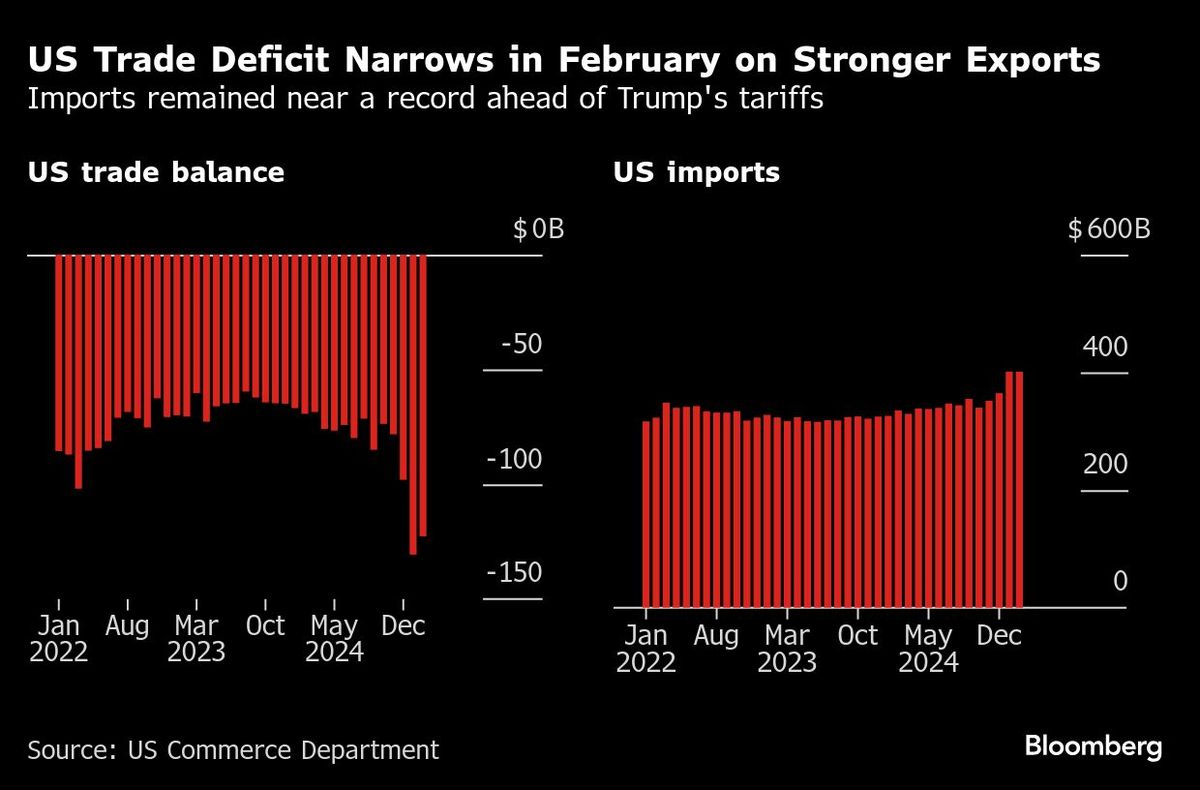
(April 3): The US trade deficit shrank in February from a record at the start of the year as stronger exports blunted the impact of a rush to secure goods and materials before the Trump administration’s sweeping tariffs.
The gap in goods and services trade narrowed 6.1% from the prior month to US$122.7 billion (RM545.13 billion), Commerce Department data showed Thursday. The median estimate in a Bloomberg survey of economists called for a US$123.5 billion shortfall.
The value of exports rose 2.9% in a broad advance, while imports remained near a record. The figures aren’t adjusted for inflation. Merchandise imports declined slightly on a pullback in industrial materials, while most other categories such as business equipment, consumer goods and motor vehicles increased.
The report comes as the world is still processing President Donald Trump’s rollout of reciprocal tariffs on Wednesday, which assigns a baseline rate of 10% globally. But several countries, like China and Vietnam, will be hit with levies much higher than that.
Imports may very well fall in the coming months — which would help to narrow the trade gap, one of Trump’s aims with his policy — as businesses try to avoid outsourcing expensive foreign goods.
Trump is employing tariffs to ensure fairness in bilateral commerce, encourage foreign investment and expand production in the US, and shore up national industrial security. He also sees duties as a means to raise revenue for the government.
Last month, Trump handed down 25% duties on certain goods from Canada and Mexico, imposed a global duty on aluminium and steel, and doubled tariffs on Chinese goods to 20%. The president also followed through on a threat to implement a 25% tariff on auto imports that just took effect.
The February report showed the merchandise-trade shortfall with Canada narrowed after reaching a record a month earlier on a seasonally adjusted basis, while the deficit with Mexico widened to a record.
The merchandise-trade deficit with China narrowed as the value of goods exported to the US declined.
Industrial supplies
The US report showed a US$4.2 billion decline in the value of inbound shipments of industrial supplies. These include metals, petroleum, lumber and other products typically used in the production of other goods.
Much of the widening in the trade deficit since the end of 2024 can be traced to imports of gold bars — which are classified as finished metal shapes.
While the trade report showed a decline in February, stockpiles on the New York commodity exchange have surged on safe-haven buying and prior concerns that precious metals would be included in Trump’s tariffs. Details from Wednesday’s Rose Garden announcement at the White House showed bullion is excluded.
Gold for investment purposes is excluded from the US government’s calculation of gross domestic product. Even allowing for the exclusion of gold, the US trade deficit will probably widen in the first quarter compared with the prior three months.
Prior to the February trade data, the Federal Reserve Bank of Atlanta’s GDPNow forecast pencilled in a 1.4% decline in the first quarter, with net exports subtracting about 2.5%. Both figures are adjusted for trade in gold.
The concern of most economists now is that Trump’s actions will result in higher prices and slower economic growth as companies grapple with severe supply chain disruptions and higher costs. Global equity markets tumbled, including a steep decline in US stock futures.
On an inflation-adjusted basis, the merchandise trade deficit narrowed slightly to US$135.4 billion in February after hitting a record at the start of the year.
Survey data from the Institute for Supply Management earlier this week suggested US manufacturers’ demand for foreign goods has since levelled off as the group’s imports gauge declined in March for the first time in four months.
Separate data out Thursday showed weekly continuing jobless claims increased to the highest level since November 2021. Another report noted more than 280,000 job cuts in the federal government were announced over the past two months, according to data from outplacement firm Challenger, Gray & Christmas.
Uploaded by Chng Shear Lane
- Sapura Resources sues ex-MD Datuk Shahriman and others for over RM3 mil in damages
- MSM sued by Ranhill over termination of effluent treatment plant project in Johor
- Chin Hin, HeiTech Padu, MyEG, MSM, Ranhill, Toyo Ventures, YNH Property
- Sell-off accelerates on Wall Street, traders weigh risks as tariffs on China increased to 145%
- Malaysia must brace for potential US pharmaceutical tariff, says Dzulkefly

